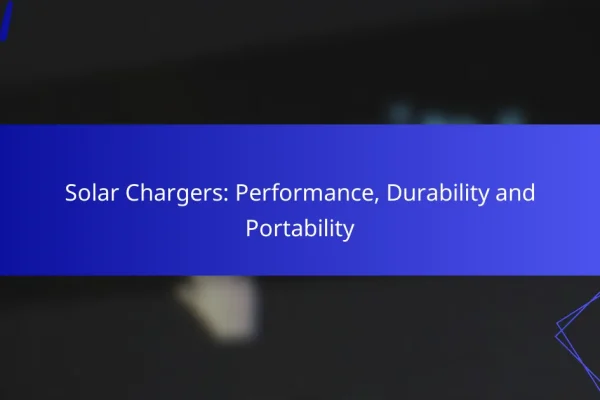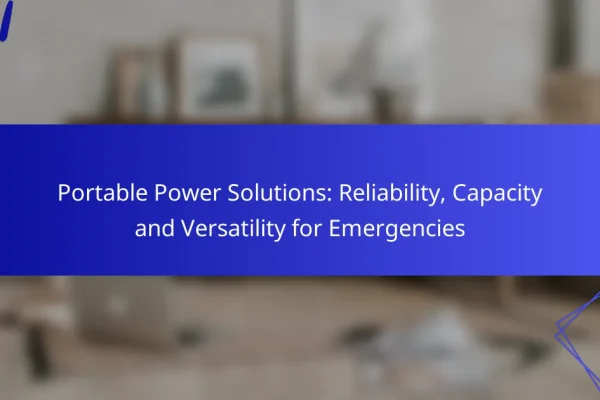What are the best portable power solutions for outdoor activities?
The best portable power solutions for outdoor activities include high-capacity power stations and compact battery packs that can efficiently charge devices. These solutions are essential for camping, hiking, or any outdoor adventure where access to electricity is limited.
Jackery Explorer 1000
The Jackery Explorer 1000 is a versatile power station that offers a capacity of 1002Wh, making it suitable for powering multiple devices simultaneously. It features various output options, including AC, USB, and DC ports, allowing you to charge everything from smartphones to small appliances.
This power station is equipped with a solar panel input, enabling you to recharge it using solar energy, which is ideal for extended outdoor trips. Keep in mind that its weight (around 22 lbs) may be a consideration for backpacking, but it is manageable for car camping.
Goal Zero Yeti 500X
The Goal Zero Yeti 500X is another excellent portable power solution with a capacity of 505Wh. It is designed for outdoor enthusiasts who need reliable power for devices like laptops, cameras, and lights. The Yeti 500X has multiple output options, including USB-C, AC, and 12V ports.
This model supports solar charging and can be paired with Goal Zero solar panels for off-grid power. Its compact design and weight of approximately 12.9 lbs make it a good choice for those who prioritize portability without sacrificing power.
Anker Powerhouse 200
The Anker Powerhouse 200 is a compact and lightweight power bank with a capacity of 213Wh, perfect for short outdoor trips. It features a variety of ports, including USB-A, USB-C, and AC outlets, making it versatile for charging smaller devices like phones and tablets.
This power solution is particularly user-friendly, with a simple interface and fast charging capabilities. Weighing around 6.5 lbs, it is easy to carry, but its lower capacity means it may not be suitable for powering larger devices for extended periods.
How do portable power stations work?
Portable power stations function by storing electrical energy in batteries, which can then be used to power various devices. They typically convert this stored energy into usable AC or DC power through built-in inverters, making them versatile for outdoor activities or emergency situations.
Battery technology explained
Portable power stations primarily use lithium-ion batteries due to their high energy density and longevity. These batteries can provide a substantial amount of power while remaining lightweight, making them ideal for mobility.
When selecting a portable power station, consider the battery capacity, usually measured in watt-hours (Wh). A capacity of around 500-1000 Wh is sufficient for charging small electronics, while larger units can power appliances like refrigerators or power tools.
Inverter functions
The inverter in a portable power station converts the DC power stored in the battery into AC power, which is what most household appliances require. Inverters can vary in quality, affecting the efficiency and stability of the power output.
Look for pure sine wave inverters for sensitive electronics, as they provide a cleaner power signal. Modified sine wave inverters are less expensive but may not work well with all devices, particularly those with motors or sensitive circuits.
What are the key features to consider when buying a portable power solution?
When selecting a portable power solution, focus on battery capacity, portability and weight, and output ports compatibility. These features directly impact how effectively the device meets your power needs while remaining convenient for transport.
Battery capacity
Battery capacity, measured in watt-hours (Wh) or milliamp-hours (mAh), indicates how much energy the power solution can store. A higher capacity allows for longer usage times, making it essential for outdoor activities or emergencies. For most users, a capacity between 20,000 mAh to 50,000 mAh is sufficient for charging multiple devices.
Consider your devices’ power requirements when evaluating capacity. For example, a smartphone typically requires around 10-15 Wh for a full charge, while a laptop may need 50 Wh or more. This will help you determine the right capacity for your needs.
Portability and weight
Portability and weight are crucial factors, especially if you plan to carry the power solution during travel or outdoor activities. Look for models that weigh less than 2 kg for easy transport, while still providing adequate power. Compact designs can fit in backpacks or carry-ons without adding significant bulk.
Evaluate the size and shape as well; some portable power solutions come in slim profiles that are easier to store. Always consider how often you will need to move the device and choose one that balances power and portability effectively.
Output ports and compatibility
Output ports and compatibility determine how many devices you can charge simultaneously and the types of devices supported. Common ports include USB-A, USB-C, and AC outlets. Ensure the power solution has a mix of these ports to accommodate various devices, from smartphones to laptops.
Additionally, check for compatibility with fast charging standards like Quick Charge or Power Delivery, which can significantly reduce charging times. A versatile power solution will offer multiple output options to meet diverse charging needs.
What are the top brands for portable power solutions?
The leading brands for portable power solutions include Renogy, EcoFlow, and Rockpals. These companies are known for their reliable and innovative products that cater to various power needs, from camping trips to emergency backup systems.
Renogy
Renogy specializes in solar power solutions, offering a range of portable solar generators and panels. Their products are particularly popular among outdoor enthusiasts and those looking to harness renewable energy for off-grid living.
When considering Renogy, look for features such as battery capacity, inverter wattage, and solar input options. Their generators typically range from a few hundred to several thousand watts, making them suitable for different applications.
EcoFlow
EcoFlow is known for its fast-charging portable power stations, which can recharge in under two hours. Their Delta and River series are particularly favored for their high capacity and versatility, making them ideal for both recreational and emergency use.
Key considerations for EcoFlow products include the number of output ports, total capacity, and weight. Their power stations often come with multiple AC, USB, and DC outputs, allowing users to charge various devices simultaneously.
Rockpals
Rockpals offers affordable and lightweight portable power stations, making them a great choice for budget-conscious consumers. Their products are designed for ease of use and portability, suitable for camping, road trips, or emergency situations.
When selecting a Rockpals power station, consider the wattage, battery capacity, and additional features like solar charging compatibility. Their models typically range from around 250 watts to over 500 watts, providing ample power for small appliances and devices.
What are the advantages of solar-powered portable chargers?
Solar-powered portable chargers offer a sustainable way to keep devices charged without relying on traditional electricity sources. They harness sunlight to generate energy, making them an eco-friendly option for outdoor enthusiasts and those in remote areas.
Eco-friendly energy source
Solar-powered chargers utilize renewable energy, significantly reducing carbon footprints compared to conventional chargers. By converting sunlight into electricity, they help decrease reliance on fossil fuels and lower greenhouse gas emissions.
Many solar chargers are designed with durable materials, making them suitable for outdoor use. They often have features like weather resistance, allowing users to charge devices even in less-than-ideal conditions.
Independence from grid power
Using solar-powered portable chargers grants users the freedom to charge devices anywhere sunlight is available, eliminating dependence on grid electricity. This is particularly beneficial for camping, hiking, or traveling in remote areas where power outlets are scarce.
When selecting a solar charger, consider factors such as solar panel efficiency and battery capacity. A charger with a higher wattage can charge devices faster, while larger battery storage allows for multiple charges before needing sunlight again.
How to maintain and prolong the life of portable power solutions?
To maintain and prolong the life of portable power solutions, it is essential to follow best practices in charging, storage, and usage. Proper care can significantly enhance battery performance and lifespan, ensuring reliable power when needed.
Proper charging techniques
Using the correct charging techniques is vital for maximizing the lifespan of portable power solutions. Always use the charger that comes with the device or one that meets the manufacturer’s specifications to avoid overcharging or damaging the battery.
Charge your device in a cool, dry place, as extreme temperatures can negatively impact battery health. Aim to keep the battery level between 20% and 80% for optimal performance, as fully discharging or overcharging can shorten its lifespan.
Consider using smart chargers that automatically stop charging when the battery reaches full capacity. This feature can help prevent overcharging and reduce wear on the battery, promoting longevity.










